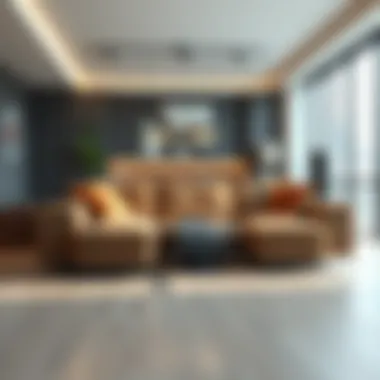The Mobile Couch: Redefining Modern Living Spaces


Intro
Urban living presents unique challenges, particularly when it comes to furnishing compact spaces. As cities grow denser, the need for adaptable and mobile furniture solutions becomes more pronounced. Among the essentials in this domain are couches that can seamlessly transition from a cozy nook to a multi-functional space, easily moving to accommodate activities like hosting guests or creating room for play. The convenience of these couches derives not only from their mobility but also from thoughtful design that does not sacrifice style for functionality.
In this guide, we will explore the salient features of mobile couches, and the materials commonly used in their construction, providing insights that empower both homeowners and interior designers. The article will cover current trends in furniture design and offer practical tips on selecting the right couches to enhance the livability of various environments. You will also find recommendations on how to maintain these versatile pieces without losing their appeal.
Furniture Design Trends
As consumers increasingly favor flexibility and sustainability, furniture design is evolving rapidly. Mobile couches, in particular, are at the forefront of this evolution, embodying the idea of providing stylish solutions for modern living. Let's delve into some trends shaping the design landscape today.
Current Trends in Furniture Design
- Sustainable Materials: Many brands are turning toward eco-friendly materials. Couches made from recycled polyester or sustainably sourced wood are becoming more mainstream, aligning with consumer demand for environmentally conscious products.
- Modular Designs: Couches that can be reconfigured to meet changing needs are gaining traction. These pieces often come in sections that can be combined or separated to suit various room layouts.
- Minimalism: Clean lines, simplicity, and function over ornate details are favored. Minimalist mobile couches can fit into various design styles without overwhelming a space.
- Functionality Meets Aesthetics: There’s a push towards couches that don’t just look good but serve multiple purposes. Pieces that offer storage solutions or convert into beds provide added value in smaller apartments.
Influential Designers to Follow
Keeping an eye on influential designers can help you spot trends early on. Here are a few noteworthy names:
- Patricia Urquiola: Known for her playful yet functional furniture design.
- Ronan and Erwan Bouroullec: Celebrated for their innovative and modular systems that emphasize mobility.
- Faye Toogood: Blending art and usability, her designs often feature earthy materials and simple forms, ideal for urban living spaces.
Practical Tips for Furniture Selection
Choosing the right mobile couch involves careful thought about not only the aesthetic but also practical aspects that enhance your living experience.
Choosing the Right Materials
Going for durable materials is crucial for long-lasting use. Consider:
- Leather: Offers a sophisticated look and is durable, though it may require regular maintenance.
- Microfiber: Stains can be cleaned easily, making it a practical choice for families.
- Bamboo: A sustainable option that also adds a natural element to your space.
Maximizing Space with Smart Furniture Choices
Here are some pointers that can help streamline your furniture selection:
- Measure Your Space: Before buying, measure your living area carefully, ensuring you know any constraints such as door frames and turn angles.
- Look for Versatile Pieces: Consider couches that can transform into lifts or accommodate reclining functions.
- Consider Color and Texture: Light colors can create an illusion of space, while rich textures add depth without bulk.
Understanding Mobility in Furniture
In the dynamic world we live in today, the concept of mobility in furniture has taken on a new significance. When considering how space is used efficiently, especially in urban settings, having furniture that can easily be moved around becomes increasingly important. The age-old adage, "less is more," resonates even louder in small apartments and multi-functional rooms, where the layout needs to adapt to a variety of activities—be it lounging, working, or hosting friends. Mobility plays a critical role in ensuring that these living environments remain flexible and accommodating.
Defining Mobility
Mobility in furniture primarily refers to the ease with which pieces can be moved and rearranged. It's not just about having wheels attached to couches; it's about creating an overall design that is lightweight, compact, and conducive to a fluid lifestyle. Consider a couch that can be repositioned without breaking a sweat—this goes beyond aesthetics; it enhances functionality.
Key characteristics include:
- Lightweight construction: Fabrics and frames that don’t weigh a ton.
- Smart design features: Items that are designed to be moved easily.
- Versatile shapes: Allowing for various configurations in a space.
Notably, mobility can involve a blend of traditional and modern solutions. For instance, incorporating modular elements means each piece serves a purpose individually while also contributing to a larger cohesive unit when needed. This makes it easier to adjust layouts based on specific guest arrangements or daily activities.
Importance of Mobility in Modern Living Spaces
Why should one prioritize mobility when selecting furniture? Here are a few compelling reasons:
- Adaptability: In the fast-paced life of today's urban dwellers, needs change almost daily. One day, the living room doubles as a workspace, and the next it's set for an impromptu get-together.
- Space Optimization: For those living in smaller homes, each square foot counts. Mobile furniture allows for quick and efficient reconfigurations, maximizing the utility of every inch.
- Ease of Cleaning: Mobility reduces the hassle of cleaning, letting owners shift furniture aside to reach those tricky corners.
"The furniture reflects not just taste but also the lifestyle of its user; mobility answers the call of both convenience and style."
In essence, understanding mobility in furniture is not merely about practicality; it encompasses the essence of modern living. As we strive for comfort within our limited spaces, the significance of easily movable couches becomes not just an aesthetic choice, but a strategic necessity in creating adaptable, inviting homes.
Key Features of Easy-to-Move Couches
When it comes to furniture, especially in compact living environments, having a couch that can move as easily as you might need can ensure your space remains versatile. Key features of easy-to-move couches play a crucial role in delivering both functionality and comfort. However, there are several elements to consider:


- Mobility Design: Mobility isn’t just about wheels or lightweight forms; it’s about a thoughtful design that accounts for a myriad of daily challenges.
- Adaptability: A flexible couch can shift to accommodate guests, seasonal decor, or simple day-to-day rearrangements, truly making it adaptable for any occasion.
- Comfort Versus Convenience: Balancing comfort with the convenience of mobility is fundamental. A couch can't compromise durability for lightness; it must serve both functions well.
Lightweight Materials
Aluminum and Steel
Aluminum and steel have become popular choices in modern couches primarily due to their inherently lightweight yet sturdy characteristics. Aluminum, for instance, does not rust and is resistant to corrosion, making it an ideal choice for various climates. Steel, albeit heavier, offers a kind of robustness that can stabilize the structure of a couch without adding unnecessary weight. These materials combined can create a couch that's easy to move yet robust enough for daily use.
Consider also that aluminum allows for sleek designs without bulk, while steel provides support, especially in frames. However, the downsides can include price—these materials aren’t always the cheapest option—and the need for occasional care to avoid scratches or dents.
Hybrid Forms
Hybrid forms refer to the combination of different materials, such as wood with metals like aluminum. This fusion not only increases durability but also enhances aesthetic appeal, catering to modern tastes. The key characteristics lie in their innovative structures that combine the sleekness of metal with the warmth of wood, creating a harmonious blend of style and function. Hybrid offerings allow for versatile designs and an appealing variety that fits sophisticated tastes. On the downside, a hybrid couch might require more specialized cleaning to maintain both materials effectively.
Fabric Types
The choice of fabric is paramount in standing against wear and tear while providing comfort. There’s a world of options, from performance fabrics to natural options like cotton and linen. Performance fabrics, for example, are engineered to resist stains, keep their shape, and allow for easy cleaning. On the other hand, natural fibers offer warmth and comfort that synthetic materials sometimes can’t match but may lack in durability long-term. Picking the right fabric ensures the couch embodies both ease of movement while fitting seamlessly into the homeowner’s desired aesthetic.
Compact Designs
Modular Configurations
Modular configurations allow for incredible flexibility in layouts. These designs are composed of individual sections that can be rearranged or removed depending on your space’s requirements. A key characteristic is their ability to create seating solutions that fit any room size, making them immensely beneficial for urban dwellers. Their unique feature is truly the capacity to adapt to varying layouts without compromising seating comfort. However, buyers should consider the potential for pieces to separate, which occasionally leads to the loss of individual elements.
Sofa Beds and Loveseats
Sofa beds and loveseats are perfect for maximizing space, providing dual functionality. Sofas that convert into beds are essential for those who frequently host guests. They offer significant sleeping support without demanding extra room. One of the appealing features of these designs is their clever engineering that facilitates a simple transformation while maintaining aesthetics. A downside could be that the mattress inside may not equal the comfort of a dedicated bed, but many contemporary designs are improving in this regard.
Mobility Aids
Built-in Wheels
Built-in wheels can truly enhance the mobility of couches, allowing users to move them easily from one place to another. The essence of these wheels is that they encourage spontaneity within space management. Moving sofas across rooms or rearranging for gatherings becomes effortless. However, one must consider the flooring; wheels can sometimes mark or scratch certain surfaces, demanding caution in choice of use.
Handles and Grips
Handles and grips are another practical enhancement in promoting mobility without complicated mechanisms. Their key characteristic is providing an intuitive means to lift or slide furniture, making it user-friendly. It’s almost a simple solution that firmly addresses the everyday hustle of moving couches. However, an aspect to weigh is that not all sofas may incorporate handles seamlessly into their design, which can detract from the overall aesthetic depending on style preference.
The features mentioned here not only promote mobility but actively undergo continual innovation to address the challenges of modern living. Investing in these key aspects will lead to an arrangement that suits the complexities of contemporary frontiers in home design.
Considerations for Buyers
When looking into mobile couches, several elements are paramount for potential buyers to take into account. Mobility isn't just about being able to physically move the couch; it encompasses aspects like scale, functional needs, and financial feasibility. These considerations inform how well a couch will serve the living space and adapt to changing needs.
Size and Scale
Measuring Space
The first step in selecting a mobile couch is understanding the dimensions of your space. Not all rooms are created equal; they vary in size, shape, and layout. Measuring space properly helps avoid the common pitfall of purchasing a piece that simply won't fit. A crucial aspect here is recognizing the significance of both vertical and horizontal space. It's not just about how much ground a couch occupies but also its height relative to the room's ceiling and furniture.
This attention to detail can significantly influence your comfort and living experience. For instance, in a small studio, a couch that juts out too far can make the area feel cramped. Moreover, a well-measured couch allows for optimal flow in the space. You'll want it to serve as a functional centerpiece without blocking pathways. Therefore, mastering the art of measurement isn’t just beneficial; it’s essential.
Choosing Proportions
Once you have measured your space, the next step is choosing proportions wisely. Proportions refer to the scale of the couch in relation to other items in the environment. A couch that is minerally out of scale can distort the aesthetic coherence of your living area.
For example, pairing a hefty sectional with delicate accent pieces can create an unbalanced look, while a light and streamlined couch might harmonize seamlessly with a more eclectic decor. Finding the right balance helps maintain a visual rhythm in the room. As such, understanding proportions can significantly elevate the overall design, fostering a space that is both functional and appealing.
Functional Requirements
Seating Capacity
Seating capacity is another crucial factor in choosing a mobile couch—especially for those who frequently entertain guests or have larger families. The right couch should comfortably accommodate everyone without feeling like a game of sardines.


This feature is particularly important for urban dwellers who might often host friends in smaller spaces. Selecting a couch with enough seating can make your home welcoming. However, it’s also useful to consider how you plan to use the couch. A more intimate setting may lend itself better to smaller options, where seating capacity holds less sway.
In summary, ensuring you have appropriate seating can enhance the social dimension of your living area.
Utility Versus Aesthetics
Utility and aesthetics often go hand-in-hand, yet finding the right balance between the two can be a challenge. Mobile couches tend to prioritize functionality, but many modern designs do not compromise on style. Understanding this balance allows buyers to select pieces that serve both practical and visual roles.
For example, a minimalist couch may be ideal for utility, snugly fitting into cramped quarters, but throw in some elegant cushions or a vibrant throw, and you elevate its aesthetic without sacrificing its core purpose. Buyers need to keep in mind that while aesthetics can enhance the appeal of the space, functional attributes often take center stage in everyday use.
Budget Constraints
Affordability Considerations
Many buyers find themselves grappling with the financial side of purchasing a mobile couch. Affordability is a significant concern—especially for those furnishing an entire home. It’s essential to set a realistic budget that takes into account not only the couch's price but also potential delivery charges and any future maintenance.
This consideration is important because high-quality mobile couches can be an investment. They should last long enough to be considered a wise purchase. It’s prudent to shop around, compare various price ranges, and be aware of end-of-season sales that may offer discounts. Being financially sound about your choices will make the purchase feel sustainable in the long term.
Long-Term Investment
Buying a mobile couch isn't just a one-time decision; it’s a long-term investment in your home. As needs and lifestyles change, so may your furniture requirements. Assessing a couch's longevity—its durability, materials used, and adaptability—is critical to making a sound investment.
You might want to consider couches with high durability ratings or warranties as those can deliver peace of mind. A piece that survives the test of time pays dividends beyond immediate comfort; it shapes how a home feels over many years. Thus, evaluating the long-term value of your purchase can ensure that the couch contributes positively to your living space for years to come.
Design Trends for Mobile Couches
In today’s fast-paced urban life, the role of furniture transcends mere aesthetics and comfort; adaptability is king. Design trends for mobile couches have become crucial as they mirror the evolving demands of modern living. These trends not only emphasize the functionality of the sofa but also highlight how it embraces style, reflects personal taste, and optimizes available space. Whether a small apartment or an expansive loft, the adaptability of mobile couches offers solutions that are both chic and practical.
Contemporary Styles
Minimalistic Approaches
Minimalistic approaches in furniture design have gained substantial traction over the last few years. This trend leans into the theory that less is more. A hallmark of this style is its clean lines and uncluttered shapes, which can significantly declutter visual space, making a room feel open and airy.
One significant contribution of minimalistic designs within the context of mobile couches is the way they streamline movement. Without bulky frames or excessive cushions, these sofas can easily be rearranged without a fuss. A unique feature is the use of modular sections that allow customization without overwhelming the senses or infringing upon limited space. Consequently, this translates to versatility and ease of movement, which are essential as city dwellers often shift their layouts frequently.
The main advantage of minimalistic couches is how they complement a wide range of interior styles, from industrial to bohemian. However, potential disadvantages include a lack of plush comfort that some individuals might expect from a couch. These styles mostly favor aesthetics over coziness, which might not cater to everyone’s preferences. Still, for those who appreciate a sleek vibe, minimalism is undeniably a popular choice.
Scandinavian Influences
Scandinavian influences draw heavily on natural elements and functional design, resulting in mobile couches that are not only stylish but also deeply rooted in practicality. The key characteristic of this approach is the emphasis on simplicity and a connection with nature, merging aesthetics with usability.
One unique feature is the use of organic or sustainable materials, which not only enhance the visual appeal but also ensure durability. Pieces often feature light wood frames and soft fabrics that beckon you to sit down and stay awhile. The benefits are manifold; these couches are easy to move due to their lightweight construction and provide a warm, inviting atmosphere where family and friends can gather.
However, while Scandinavian designs may excel in functionality and comfort, there may be a risk of appearing too generic in some settings. The aesthetic is ubiquitous, which might not appeal to those seeking a more distinct or individualized style. Yet, for those targeting functional beauty within their home environment, this influence remains a significant contender in the mobile couch category.
Color and Fabric Trends
When it comes to colors and fabrics for mobile couches, trends vary significantly from bold, vibrant hues to soft, muted palettes. Designers today often play with texture and color to create interesting visual contrasts while prioritizing comfort. It’s worthwhile to consider both modern trends and timeless choices.
"The colors and fabrics chosen for a mobile couch can truly transform a space, making it feel more inviting or energizing, depending on the palette."
- Bold Colors: Bright, vivid tones can serve as statement pieces, energizing a room and sparking conversation. Popular choices like teal or mustard yellow add character without compromising on flexibility.
- Natural Fabrics: Utilize materials like linen or cotton that resonate with the ethos of comfort, further merging the practical aspects of mobility with the need for a cozy feel. These fabrics are generally easier to clean, align with sustainability goals, and provide a lasting appeal.
Navigating through these trends allows potential buyers not only to make better-informed choices but encouraging them to think critically about how their living environment aligns with their personal style and needs.
Maximizing Space with Mobile Couches
As urban living spaces grow smaller and more multifunctional, maximizing space becomes imperative for homeowners and designers alike. Mobile couches play a vital role in this context by offering flexibility in arrangement, accommodating different needs without sacrificing style or comfort. Being able to move a couch effortlessly can transform a cramped room into a spacious haven. This section explores the various strategies for utilizing mobile couches to create optimal living areas, focusing on flexible layouts and furnishings for small apartments.
Creating Flexible Layouts
Creating flexible layouts is all about ensuring that living spaces can adapt to different activities and needs throughout the day. The main advantage of mobile couches is their capacity to be repositioned with ease, allowing for dynamic use of residential environments.


Zoning Spaces
Zoning spaces refers to the practice of delineating areas within a larger room for specific activities or functions. This strategy shines particularly well with mobile couches, as these pieces of furniture can be rearranged to suit various setups. For instance, a couch can mark the boundary between a cozy reading nook and a small dining area, promoting better use of space without the need for additional partitions.
One key characteristic of zoning spaces is the emphasis on functionality without clutter. By utilizing mobile couches in zoning, homeowners can cultivate distinct yet harmonious environments, streamlining both movement and usage. These couches can be moved to create an open area for entertaining guests or repositioned into a more intimate layout for family gatherings. The unique feature of zoning is that it enhances flow and connectivity within a room, bolstering usability and aesthetic appeal. However, it’s worth noting that excessive repositioning or lack of defined edges can sometimes lead to a visually disorganized environment, requiring careful planning and design consideration.
Multipurpose Areas
Multipurpose areas take the concept of zoning up a notch by incorporating furniture, like mobile couches, that serve more than one role. A mobile couch in a living area can double as a sleeping surface, a hub for family game night, or even provide added seating during movie marathons.
Characteristic of multipurpose areas is their versatility, allowing homeowners to maximize their limited floor space. This makes it a favorable choice for modern urban dwellings where every square foot matters. A notable advantage is that homeowners can keep their budgets in check by selecting multifunctional furniture instead of investing in single-purpose pieces. However, fitting too many functions into one area—or relying solely on mobile couches without considering other furniture—can sometimes compromise comfort or accessibility, creating a less welcoming environment.
Furnishing Small Apartments
Furnishing small apartments presents its own unique set of challenges, where space limitations require careful thought and planning. Mobile couches become essential allies in crafting practical yet stylish environments. For instance, opting for a compact, mobile sectional can help to utilize limited space while still offering aesthetics and comfort.
Mobile couches are not just limited to one type of design; they can adapt to various stylistic choices, fitting seamlessly into minimalistic or eclectic designs. The trend towards fewer large items and more adaptable, smaller pieces reflects the needs of urban dwellers who prioritize flexibility alongside comfort.
In summary, maximizing space with mobile couches ultimately leads to more fluid, enjoyable living spaces that meet the diverse needs of their inhabitants. Whether through creating flexible layouts or furnishing small apartments, the thoughtful integration of mobile couches can redefine how residents experience their homes.
Maintenance of Mobile Couches
Proper maintenance is paramount when it comes to mobile couches. These versatile furniture pieces often move about between spaces, making them prone to wear and tear. A proactive maintenance routine not only extends the life of your furniture but also keeps it looking fresh and appealing.
Cleaning Recommendations
Material-Specific Care
Every type of material used in a couch has its own quirks and needs. For instance, leather requires a different touch than fabric. Understanding these nuances is key to maintaining the look and feel of your couch.
- Leather: It’s rather durable but can be susceptible to scratches; using a soft cloth with a specialized leather cleaner can restore its shine.
- Microfiber: This is a popular choice for mobile couches due to its stain resistance. It can often be cleaned with just a damp cloth, making upkeep a breeze.
- Cotton and Linen: While breathable, these fabrics require thorough cleaning to avoid dust build-up. It’s advisable to machine wash removable covers frequently.
Material-specific care ensures longevity and retains the beauty of the couch. Skipping this step may lead to irreversible damage, which can be costly.
General Cleaning Techniques
Incorporate some basic cleaning techniques into your routine to keep your mobile couch in tip-top shape:
- Vacuum Regularly: Use a handheld vacuum to suck up crumbs and dust. This helps prevent buildup and keeps allergens at bay.
- Spot Clean: For spills and stains, act fast. Dab the area with a clean cloth; never rub it, as it may spread the stain.
- Steam Cleaning: Consider steam cleaning for a deeper cleanse, but check the fabric guidelines first to ensure it’s safe.
General cleaning techniques can make a world of difference. They are often less intimidating and become second nature over time, making couch upkeep manageable and straightforward.
Preventing Wear and Tear
Preventing wear and tear is crucial for mobile couches. Regular maintenance is great, but keeping the couch safe from potential damage is just as important. Here are some strategies to ensure your couch lasts:
- Avoid Direct Sunlight: Position your couch in a way that avoids harsh sunlight, which can fade colors over time.
- Keep Pets in Check: If you have furry friends, protect your couch with covers or throw blankets to prevent claw marks and fur.
- Use Furniture Coasters: When moving the couch around, use coasters or sliders to protect the legs from scratches and dents.
In essence, a well-maintained couch is not only more pleasing to the eye but also contributes positively to your living space's comfort and atmosphere.
"Regular upkeep of mobile couches saves both time and money in the long run—treat them well, and they'll stand the test of time."
By embracing these maintenance practices, you can preserve the integrity, comfort, and aesthetic appeal of mobile couches, making them a worthwhile investment for any modern living space.
The End
The concept of mobility in furniture design has garnered unprecedented significance, particularly evident in the growing market for mobile couches. This article has explored various elements related to this trend, delving into how these versatile pieces of furniture cater to the diverse needs of modern urban living. With changing lifestyles and evolving design preferences, mobile couches offer not just convenience, but a means to adapt one’s living space effortlessly.
Highlighting the future of mobility in furniture design, we see a clear pivot towards emphasizing functionality without sacrificing style. As cities become more densely populated, where square footage often comes at a premium, these adaptable designs hold immense value. They allow homeowners to be resourceful in making effective use of their space— switching a living room into a home office or entertaining area with just a few adjustments.
In terms of benefits, mobile couches are not merely about moving them from point A to point B; they serve as anchors for dynamic lifestyles, enhancing fluidity in living arrangements. Consider the ease with which they can transition from casual family gatherings to formal entertaining spaces. Additionally, they represent an investment not just in furniture, but in a lifestyle conducive to flexibility.
When looking ahead, it's essential for both designers and consumers to embrace this evolving dialogue between mobility and aesthetics. Emphasizing sustainable materials and ergonomic designs will likely play a pivotal role in shaping choices, ensuring that the pieces do not just function well, but also reflect personal style and values.
Ultimately, the trajectory for mobile couches melds practicality with aesthetic appeal, catering to a broad audience including interior designers, homeowners, decorators, and realtors alike. It emboldens the message that a well-curated space is one that can grow and shift as life happens.
"Furnishing a home isn’t just about the pieces; it’s about how they come together to tell the story of life lived within those walls."
Following the outlined discussions, one must weigh their options carefully, considering size, functionality, and design trends that honor individual tastes while promoting versatility. The future may hold even more innovative arrangements, encouraging a rethinking of how we perceive and utilize our living spaces. With mobile couches paving the way, it’s clear that adaptability in furniture design is a crucial aspect of contemporary living.



